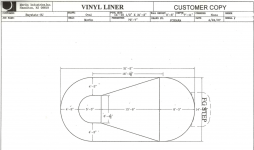I have an oval pool 15.5x31.5 with deep end of 8.5 and shallow 3
InYoPools says take 15.5 x 31.5 x 5.75 (Avg Depth) X "6.7" which = 18,810 gallons
Doheny's says take 15.5 x 31.5 5.75 (Avg Depth) X "5.9" which is - 16564 gallons
WELL WHO THE HECK DO I LISTEN TOO ???? That is a big difference !!!!
InYoPools says take 15.5 x 31.5 x 5.75 (Avg Depth) X "6.7" which = 18,810 gallons
Doheny's says take 15.5 x 31.5 5.75 (Avg Depth) X "5.9" which is - 16564 gallons
WELL WHO THE HECK DO I LISTEN TOO ???? That is a big difference !!!!




